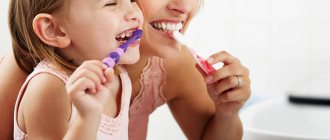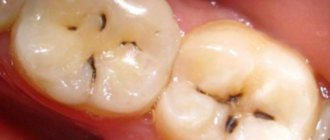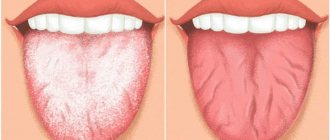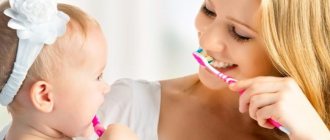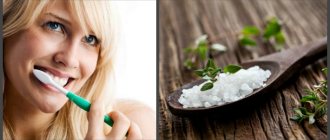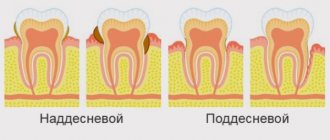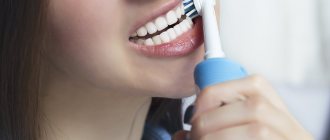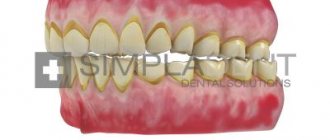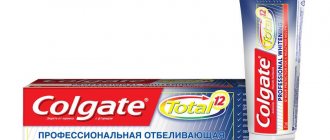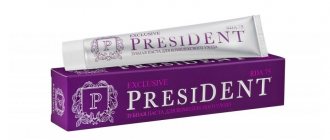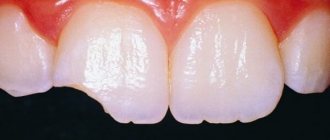Types of toothpastes
All pastes can be divided into hygienic and medicinal. The first ones are needed in order to remove plaque, refresh the oral cavity and reduce the rate of reproduction of harmful bacteria. The latter have a high concentration of active substances and are designed to solve specific problems.
Medicinal pastes are classified according to their action:
- against periodontal disease;
- for the treatment of caries;
- to get rid of tartar;
- to reduce tooth sensitivity;
- to restore enamel.
Unlike hygienic ones, such pastes are not always suitable for daily care. Some of them contain antibiotics (triclosan), antiseptics (chlorhexidine), substances to reduce bleeding gums (aluminum lactate) - the course of use of such drugs usually lasts no more than two to four weeks. Since active components can cause significant harm when used for a long time.
In addition, as we said above, there are abrasive substances in the composition of medicinal products, this is indicated by the RDA index; if it exceeds 200 units, then such a paste can be used no more than once a week.
Please note, to enhance the effect of medicated pastes, brush your teeth for at least three minutes, and then hold the foam in your mouth for a minute.
Prevention of caries: how to brush your teeth and what toothpaste to use
Thorough and proper brushing of teeth with a brush and toothpaste is the main preventative measure.
How to brush your teeth correctly: number of times a day and their duration
The American Dental Association [Verified Source] recommends that you brush your teeth twice a day , morning and evening. You can brush your teeth more often, for example, after every meal. Morning cleansing helps freshen your breath and is more likely to serve an aesthetic purpose. However, cleaning in the evening before bed is an urgent need for health in order to remove food debris and prevent the development of pathogenic microflora and plaque formation.
Teeth should be cleaned for 2 minutes using the paste, devoting an equal amount of time to each surface: external and internal chewing surfaces. Particular attention should be paid to large molars, because they are the furthest away and often contain food particles. The procedure must be carried out in a circular motion along the outer part of the teeth , since moving the toothbrush from side to side leads to enamel loss.
Which toothpaste and brush to choose?
When choosing a paste, you should pay attention to the content.
Dentists recommend choosing ones with fluoride and calcium. The first element inhibits the vital activity of streptococci, preventing them from forming bioplaque and causing caries, and the second strengthens teeth. But besides toothpaste, the brush plays an important role. It must be washed thoroughly before and after use, and also changed every 3-4 months . Store this item in an upright position and allow it to air dry.
In stores and pharmacies you can find several varieties of it: with soft, medium and hard bristles. Dentists recommend using medium-hard brushes, since this type of brush can effectively clean your teeth from plaque and food debris. However, it is necessary to select a brush individually and with a suitable bristle shape, since an unsuitable brush can injure the gums. A soft toothbrush, so beloved by many, actually cleans teeth worse and is recommended only after surgery.
How to brush your teeth well: mouthwash, toothpicks and dental floss
You can also use fluoride rinses after each meal to prevent tooth decay. They remove remaining food particles and prevent the proliferation of carious bacteria.
Dentists call toothpicks the enemy of teeth. When cleaning the interdental space, a toothpick injures the circular ligament of the tooth, which causes inflammatory processes and the penetration of bacteria deep into the tissue.
Therefore, it is recommended to use dental floss or an irrigator (a device for cleaning the interdental space with a jet of water under pressure), which safely cleans the interdental space from food particles and plaque .
How to brush your teeth: rules of oral hygiene
Proper cleaning occurs by following 9 tips from dentists. Failure to comply with at least one of them can result in ineffective removal of food particles and harmful microbes, which can lead to rotting.
9 Tips [Verified source] on how to brush your teeth well:
- Before this procedure, the brush must be thoroughly washed.
- While brushing, hold it at a 45-degree angle to the gum line.
- Apply a medium amount of paste (the size of a pea);
- First clean the outer surface, then the chewing surface and then the inner surface.
- Make only light circular movements with the brush on the inner and outer surfaces.
- It is easy to move the brush back and forth along the chewing side.
- It is also necessary to periodically clean the tongue, as a large accumulation of bacteria forms there.
- Remaining toothpaste should be spat out after brushing.
- At the end of the procedure, the oral cavity is rinsed with water.
These actions are the main measure of caries prevention. In addition to them, it is also important to exclude from the diet excessive consumption of foods that contribute to the occurrence of this disease.
Anti-caries pastes that restore enamel
Such products are designed to combat enamel demineralization and prevent the development of caries at the white spot stage. Pastes are based on calcium compounds or fluorides. You should not use products that contain both types of compounds. The fact is that fluorine and calcium react and form an insoluble residue, which means that during cleaning no active ions are released and no recovery occurs.
Calcium-containing pastes can be used every day. They are designed to correct mild thinning of the enamel.
Fluoride-containing pastes are designed to restore seriously damaged enamel. They can only be used with the permission of a doctor, as there is a risk of getting excess fluoride in the body. This can lead to brittle bones and teeth. Such products are used no more than twice a week. For greater effectiveness, they can be alternated with calcium-containing pastes.
What is caries?
Caries is the destruction of hard tooth tissues, which leads to the formation of carious cavities in the enamel and the entry of bacteria into them. This process contributes to the decay of the integrity of the tooth and its possible loss.
The main cause of caries is considered to be poor oral hygiene (infrequent and inattentive brushing of teeth), which leads to the formation of plaque. Plaque is a collection of bacteria (streptococci, lactobacilli and actinomycetes) that convert sugar from food and drinks ingested into acids that destroy enamel.
In addition, there are other causes of caries [Verified source]:
- excessive consumption of carbohydrates;
- deficiency of fluorine, calcium and phosphorus;
- hypovitaminosis (lack of vitamins);
- xerostomia (dry mouth);
- acid reflux (weakening of the esophageal sphincter and acid from the stomach entering the esophagus and oral cavity);
- eating disorders (anorexia, bulimia);
- the presence of braces and orthopedic structures in the mouth;
- consequences of rickets and scurvy suffered in childhood;
- decreased immunity.
It is quite difficult to identify dental disease at the initial stage without a professional examination by a dentist, but you should understand what caries looks like and know its symptoms in order to consult a doctor at the first manifestation.
dental caries include
- the appearance of white, brown, black spots on the enamel;
- reaction of teeth to irritants (sour, sweet);
- formation of defects in the crown of the tooth.
According to the WHO International Classification of Diseases [Official Source], there are 3 stages of dental caries.
At the beginning, you may not pay any attention to the periodic pain of the tooth, but over time, when black plaque begins to appear and a cavity forms, caries cannot be ignored.
Stages of caries:
- destruction of enamel;
- damage to dentin;
- tooth root caries.
According to WHO statistics, every inhabitant of the planet, regardless of age, undergoes at least one of them. But why is there a misconception that the destruction of hard tissues is mainly a childhood disease?
Therapeutic pastes for bleeding gums
These products contain extracts of various medicinal plants. They soothe inflamed gums, relieve swelling, reduce bleeding, eliminate itching, cyanosis and redness. In addition, these pastes relieve pain. They can be used in the treatment of periodontitis or gingivitis. But we must remember that in case of serious diseases, pastes are effective only with dental treatment.
In the absence of serious measures, such pastes can temporarily hide the symptoms, but, unfortunately, they will not cure the disease.
Pastes to reduce tooth sensitivity (hyperesthesia)
A suitable choice for anyone who experiences great discomfort from eating cold and hot foods, sweet and sour. Such pastes are also recommended for pathological abrasion of enamel, wedge-shaped defects and microcracks.
Remedies for hyperesthesia are characterized by a high concentration of fluoride and potassium, and, at the same time, a small amount of abrasive substances. To clean with such a paste, you need to use a soft brush, otherwise you will significantly reduce the positive effect.
It is also necessary to remember that you should not brush your teeth for a long time with a paste for hyperesthesia. It does not remove soft plaque well. And its accumulation over time can lead to the formation of tartar and other problems. Therefore, when the acute symptoms disappear, replace this paste with a regular hygienic one.
From the history
The mention of the first means for cleaning teeth dates back to the 3rd-5th millennium BC. The ancient Egyptians ground eggshells, pumice, ashes of ox entrails, and myrrh and prepared a product from this, which was the progenitor of tooth powder. The Greeks, Romans and Persians improved the recipe by adding shellfish shells ground into powder, crushed chalk, honey, and dried plants. The Slavs contributed to the development of dentistry by starting to brush their teeth with birch charcoal. Powders and pastes, more or less similar to modern ones, appeared in Great Britain only in the 18th century, when their use was considered the prerogative of the nobility.
Modern people are luckier - everyone can choose a product to suit their taste and budget or for medical reasons. Nowadays there are toothpastes that are not only hygienic, but also therapeutic and prophylactic, which include special additives. Let's look at them in more detail.
Hollywood smile. How to whiten teeth at home? More details
Therapeutic pastes for tartar
Hard plaque can be completely removed only by professional ultrasonic cleaning or using a special Air Flow device. Toothpastes are used more as a preventive measure; they can lighten pigmented areas and remove small plaques.
Such products are recommended for tea and coffee lovers and, of course, smokers. Typically anti-tartar pastes contain:
- a small amount of fluorine (0.1 - 0.6%);
- antiseptics;
- minimal amount of sodium lauryl sulfate.
These products are highly abrasive - the RDA index is above 100. It must be remembered that abrasives increase the permeability of enamel. This means that you will need to increase your care: use floss and rinses.
Compound
Toothpastes presented on the pharmacological market are divided into hygienic, medicinal and therapeutic-and-prophylactic based on their intended purpose. The last group of products includes mainly children's pastes. They do not contain only abrasive components and additional compounds.
Therapeutic and prophylactic drugs not only facilitate the treatment of caries, but also prevent its reappearance after dental diseases. The anti-carious effect is due to the characteristics of the paste composition:
- Fluoride and fluorine compounds. The substances have a beneficial effect on tooth enamel, strengthen it and make it less vulnerable to pathogenic flora. Fluoride pastes are recommended for people suffering from weak enamel mineralization and susceptible to carious lesions.
- Antiseptics (chlorhexidine), antibacterial enzymes (lysozyme), a special natural protein - lactoferrin, which prevents the proliferation of pathogenic agents that cause caries.
- Hydrogen peroxide and abrasives. The substances help quickly remove plaque from the enamel surface. Bacteria accumulate in it, which ultimately destroys tooth enamel. Abrasives also prevent the formation of tartar, which is the cause of periodontitis.
- Potassium ions. Preparations containing this component are intended for the care of sensitive teeth. Their enamel can be damaged by harsh abrasives, which are often included in dental care products. Potassium ions reduce the sensitivity of dentinal tubules and affect sensory nerve endings.
- Plant components. Pastes with a similar composition are prescribed in cases where, due to bleeding or hypersensitivity of the gums, patients are afraid to carry out regular oral hygiene. As a result, cervical caries develops. After the pain disappears, a person can perform a complete cleaning of the entire surface of the teeth.
When fighting caries, highly abrasive drugs can only be used with the permission of the dentist. Too frequent or prolonged use of pastes with a similar composition leads to thinning of the enamel and rapid progression of carious processes. As a result, a person using a lightening drug receives the opposite effect of the desired one.
Manufacturers of modern oral care products usually offer customers pastes with combined properties, for example, enamel strengthening and antibacterial. This makes it easier for patients who do not know which drug is right for them.
Pastes "Asepta"
The Asepta series has a wide selection of medicinal pastes that help solve various problems:
- ASEPTA ACTIVE provides teeth with comprehensive protection, helps reduce the number of pathogenic microbes and eliminate inflammatory processes in the oral cavity.
- ASEPTA SENSITIVE reduces tooth sensitivity and treats gums.
- "ASEPTA PLUS" REMINERALIZATION restores thinned enamel and protects gums from inflammation.
Regular use of Asepta products can reduce bleeding gums and improve dental health.
Clinical researches
The effectiveness of Asept toothpastes has been clinically proven:
- it has been proven that regular use of preventive toothpaste ASEPTA ACTIVE for a month can reduce bleeding gums by 60%, improve the overall condition of the oral cavity by 44% and reduce inflammation by 33%;
- It has been confirmed that regular use of preventive toothpaste ASEPTA SENSITIVE for a month can reduce bleeding gums by 62%, reduce the sensitivity of teeth and gums by 48% and reduce inflammation by 66%.
- It has been proven that regular use of professional toothpaste ASEPTA REMINERALIZATION after 4 weeks improved the condition of the enamel by 64% and reduced tooth sensitivity by 66%.
Sources:
- Clinical and laboratory assessment of the influence of domestic therapeutic and prophylactic toothpaste based on plant extracts on the condition of the oral cavity in patients with simple marginal gingivitis. Doctor of Medical Sciences, Professor Elovikova T.M.1, Candidate of Chemical Sciences, Associate Professor Ermishina E.Yu. 2, Doctor of Technical Sciences Associate Professor Belokonova N.A. 2 Department of Therapeutic Dentistry USMU1, Department of General Chemistry USMU2
- Clinical studies of antisensitive toothpaste “Asepta Sensitive” (A.A. Leontyev, O.V. Kalinina, S.B. Ulitovsky) A.A. LEONTIEV, dentist O.V. KALININA, dentist S.B. ULITOVSKY, Doctor of Medical Sciences, Prof. Department of Therapeutic Dentistry, St. Petersburg State Medical University named after. acad. I.P. Pavlova
- Report on the determination/confirmation of the preventive properties of personal oral hygiene products “ASEPTA PLUS” Remineralization doctor-researcher A.A. Leontyev, head Department of Preventive Dentistry, Doctor of Medical Sciences, Professor S.B. Ulitovsky First St. Petersburg State Medical University named after. acad. I.P. Pavlova, Department of Preventive Dentistry
What foods should you eat to avoid tooth decay?
All food products can be divided into those that provoke the appearance of bioplaque and those that prevent it.
Before examining their list in detail, it is worth noting that the temperature of the food consumed is important to maintain dental health. Contrasting in temperature, too hot or too cold dishes negatively affect the condition of the enamel, microcracks appear on it. And they contain streptococci and form biological plaque, which leads to the destruction of the crown part of the tooth.
What causes caries: foods that should not be abused
The list of them is quite large, so we will highlight the main ones [Verified source]:
- Sweets (sweets, chocolate, jam, preserves) contain a lot of carbohydrates, which are considered food for carious bacteria. They convert carbohydrates into acids that can destroy tooth enamel.
- Starchy foods (bread, buns, chips). When their particles decompose, sugar is formed, which becomes a breeding ground for harmful microorganisms.
- Sour fruits (citrus fruits), vegetables and cooked foods (sauces, syrups, marinades). They contain acids that destroy tooth enamel.
- Soft drinks and alcohol . They cause dry mouth and reduce the amount of saliva produced. Namely, saliva helps cleanse the oral cavity of food particles and plaque.
Foods and drinks that prevent tooth decay
These dishes and drinks neutralize carious actinomycetes and streptococci, strengthen the hard tissues of the crown and are useful for maintaining the normal functioning of the entire body. These include [Verified source]:
- Fruits rich in fiber . They promote the production of saliva, which is a natural defense against putrefaction, and contains traces of calcium and fluoride
- Products containing fluoride (drinking water, cereals, nuts). Ions of this chemical element inhibit the vital activity of microorganisms.
- Milk (cheese, cottage cheese). The calcium and phosphates in them help restore and strengthen tooth enamel.
- Green and black tea . The composition contains polyphenols that prevent the growth of harmful bacteria and kill them. And the water used to brew tea may contain fluoride.
- Fish . They contain calcium, phosphorus, thiamine and vitamin D, which helps strengthen tooth enamel and kill germs.
Unfortunately, effective teeth cleaning and healthy foods are means of prevention and will not help with existing pathology. In such cases, you should contact your dentist.
